Houston's SW Chinatown
Updated: 2015-01-23 06:06
(China Daily Canada)
|
||||||||
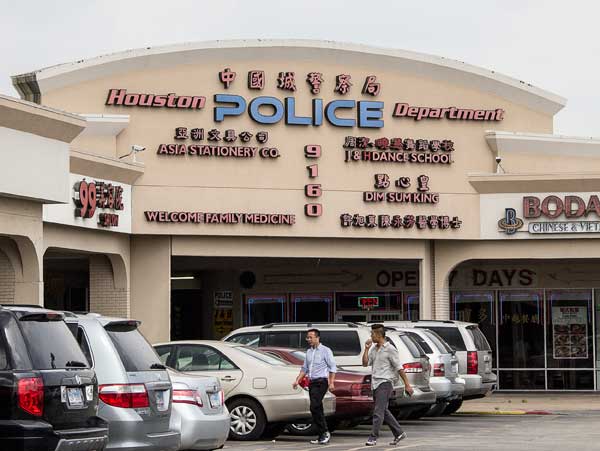 |
|
The Houston Police Department's Chinatown station has been staffed by three bilingual policemen since the early 1990s. The office is provided by D. T. Wong for free as a service to Chinatown. Photos by May Zhou / China Daily |
Houston is the fourth largest city in the United States and has the biggest Asian population in the South. The first Chinatown was established east of downtown, but today the southwest area of the city has emerged as the New Chinatown, reports MAY ZHOU from Houston.
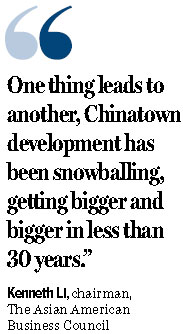
It looks like any other busy commercial street in Houston or major US metropolis, with one exception: most signs, including street names, are either in Chinese or bilingual, unmistakably announcing you have arrived at SW Chinatown, aka the New Chinatown.
Its broad streets, open space and cleanness defy the preconception — narrow streets, crowded space, mysterious atmosphere or exoticness – most people have formed from other Chinatowns in places such as New York and San Francisco.
The original Chinatown, started by older generations of Chinese immigrants primarily from south China, consisted of small shops and some restaurants along St. Emanuel and a couple of adjacent streets in southeastern downtown. It has been in steady decline since 1980s.
Today, only a few Asian wholesale businesses still exist there while part of it is being redeveloped into modern and hippie residential parcels.
Often, outsiders and new comers marvel at Houston's SW Chinatown when they first take a drive down Bellaire Boulevard westward from Gessner. Along the newly completed seven-lane thoroughfare and lining both sides are shopping centers with big Chinese supermarkets as the anchor stores, office buildings, banks and apartments. And in between, one can spot a non-Chinese private college preparatory school, a Wells Fargo branch and a Halliburton corporate complex.
There are different opinions as how to define the boundary of Houston's SW Chinatown. The most authoritative definition comes from the Asian American Business Council (AABC), a non-profit civic organization started by a group of Chinatown commercial property owners, developers, bankers and business owners in 2005 with a goal to promote SW Chinatown, improve its safety and beautify the area.
According to Kenneth Li, chairman of AABC as well as the owner of Southwest 21 Century and DIHO Square, SW Chinatown is bounded by Gessner to the east and Eldrige to the west — roughly a five-mile stretch; and about two miles long between Westpark and Beechnut from north to south, making it one of the largest motor-centric Chinatowns of more than 10 square miles in the US.
Divided by Beltway 8, SW Chinatown is split into two major sections: the east section falls into the Greater Sharpstown Management District (GSMD), while the west section falls into the International District (ID). The SW Chintown in GSMD is only a mile long along Bellaire with an area of merely 2.3 square miles, but this is the first and most developed section of SW Chinatown. Li calls this the "Golden Zone" of Chinatown with the most concentrated Chinese-American owned business and properties.
|
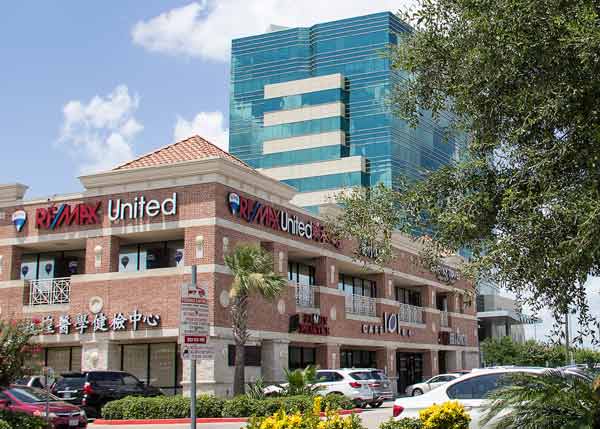 |
|
The corner of Dun Huang Plaza with the American First National Bank Building– the tallest structure in SW Chinatown - looming over in the back on Bellaire Boulevard. |
DIHO Plaza
Chinese, regardless of where they are, seem to stubbornly cling to their native cuisines. To meet their gastronomical need, Chinese restaurants open wherever they go.
And as Houston's Asian population grows — the 2010 US Census put that figure at 6 percent of the city's total population of 2,195,914 — Asian grocery stores and supermarkets pop up to meet their home cooking needs. Not surprisingly, Houston SW Chinatown started with a shopping center where a Chinese supermarket is the focal point.
In 1981, D. T. Wong, originally from Hong Kong, came to Houston from Los Angeles looking for new opportunities. "The downtown Chinatown was full and there was no space for us to get in, so we chose SW Houston and built DIHO Asian Market in 1983," said Wong's nephew Kenneth Li, who came to Houston as a college student with Wong.
Commonly known as DIHO Plaza, it was a joint endeavor by Wong with local developers. The L-shaped DIHO Plaza was based on a Hong Kong model with a supermarket as the anchor store and smaller spaces for restaurants, services or offices. The total space was 14,000 square feet.
Li said Wong chose SW Houston because in the early 1980s Houston was booming with an oil industry and this area was populated with middle-class professionals. "DIHO Supermarket was packed on its opening day," Li recalled. It soon replaced downtown Chinatown's smaller supermarkets and became the primary stop for Chinese immigrants. The seed for SW Chinatown was planted with the opening of DIHO Plaza.
The oil boom soon attracted another Chinese developer, Hong Changrui from Singapore. Hong bought five acres at the corner of Bellaire and Corporate and built an air-conditioned indoor mall along with a supermarket.
The Dynasty Mall was completed and launched in 1987. Today, one can find a bank, restaurants, beauty salon, bookstore and various types of retail business inside. Some businesses, including the Dynasty Supermarket, opened when the mall was completed and still remain there today.
In 1987, Wong and Li bought an existing shopping center on Bellaire east of Ranchester and renamed it DIHO Square. Another major supermarket Welcome was opened there to accommodate the growing need of more and more Chinese and Asian immigrants. Later, extra retail space was added to the DIHO Square.
In less than five years, three Chinese supermarkets and shopping centers opened within a quarter mile of each other and all on the north side of Bellaire. Smaller shopping centers and office space are gradually being built by or near them, spreading out like a fan.
According to Christie Qin, vice-president of Southern Chinese Daily News and a veteran community journalist since the early 1980s, during the same period the Vietnamese-Chinese operated supermarket Viet Hoa Food Market moved to the SW Chinatown on Beechnut at Gessner from downtown in 1984, and the first and smaller Hong Kong Food Market was opened at the corner of Harwin and Gessner in 1987. SW Chinatown started to take shape
Then the oil bust happened in late 1980s. However, this actually helped SW Chinatown to further develop. According to Li, "The sharp drop of real estate provided the out-of-state Chinese American investors with opportunities to enter the local market. When economy goes well, nobody wants to sell. The oil bust attracted a lot of the investors from LA and New York to Houston's Chinatown."
According to Qin, during the economic recession in the late 1980s to the early 1990s, Chinese investors bought numerous apartment complexes next to the three shopping centers. The ownership of Happy Village, Lousville, Hamilton and SunBlossom Garden switched to Chinese investors one after another. By Li's account, today over 6,000 apartments are owned by Chinese within the Golden Zone.
Development wave starts
In Li's opinion, SW Chinatown's second milestone came with the construction of the Hong Kong City Mall (HKCM) on Bellaire west of Beltway 8 in the International District.
Developed by Chinese immigrant Hai Du Duong from Vietnam, HKCM was completed and opened in the fall of 1999 with the gigantic Hong Kong Food Market, a two-story banquet hall restaurant, a lotus pond and over 100 retail stores, cafes, restaurants and services, most of which are connected to each other indoors. Fifteen years later, HKCM still boasts one of the largest shopping centers in Chinatown.
During this period, the Southern News Group media building and the International Trade Center were built on the north side of Bellaire across from HKCM. "These represent the expansion of SW Chinatown beyond Beltway 8 and the Chinatown main drag of Bellaire," said Li.
However, it's the third phase of development started in the new millennium that pushed Chinatown to a new high, according to Li.
In the first decade of the 21st century, rapid development occurred inside Beltway 8. First, Shi Shaoli, an immigrant from the Chinese mainland, developed Sterling Plaza in the early 2000s next to the Wells Fargo branch. She also developed a Ming Dynasty style townhome complex to the north of Sterling Plaza.
Also, Li developed Corporate Office Plaza south of Bellaire. Across from Sterling Plaza; Michael Chien and David Wu developed Dun Huang Plaza — the largest commercial condominium in Chinatown with covered parking, services, retails and professional offices.
To top it all, American First National Bank (AFNB) Building, a 12-story class-A office building, sprang up next to Dun Huang Plaza in 2007, making it the highest and most visible landmark in SW Chinatown.
AFIB founder Henry Wu wanted to give his bank room to expand and to give SW Chinatown a better image, and he succeeded on both accounts. Li said: "Today, this building is the most valuable real estate piece in Chinatown with a taxable appraisal value of $1 billion."
Banks as backers
David Tai, a local veteran banker and co-founder of the former Metro Bank, said that the numerous Chinese owned banks have played important roles in the development of Chinatown.
According to Tai, the first major lender was the Asian American Bank established in 1983 by older generation Chinese immigrants. It later became Concord Bank and was merged with Atlanta's Summit National Bank in 2006.
In 1985, a group of Taiwanese Chinese formed the Texas First National Bank (now Golden Bank), followed by the formation of the Metro Bank in 1987, both headquartered in SW Chinatown.
With Chinatown's development, more banks opened up: First Intentional, United Central, Southwestern National and American First National.
Major Chinese banks from California also came to Houston. Cathay Bank opened its local office as early as 1999. East West Bank started a local branch in 2004 and eventually bought Metro Bank a year ago.
By Tai's account, when Hai Du Duong, owner of Hong Kong City Mall (HKCM) came to him for a loan in the mid 1990s, the needed amount was $16 million. Metro Bank was only able to loan $5 million. To get the HKCM project going, Tai helped Duong secure loans from banks in other cities and Taiwan. Years later, Metro Bank also financed the construction of Dun Huang Plaza.
Today, at and around the intersection of Bellaire and Corporate, nine Chinese- American owned banks and five branches of mainstream banks are in operation, making it the highest density of banks in Houston. By AABC's estimate, the Chinese-American owned banks have combined assets of $35 billion. "We call this intersection the Wall Street of Chinatown," said Li.
Li pointed out that commercial business is not the only part of Chinatown. "We have community organizations such as the Chinese Community Center, the Chinese Civic Center, numerous Chinese schools, retirement home like Rainbow Village, religious groups such as Teo Chew Temple, Jade Buddha Temple, Tzu Chi and others. One thing leads to another, Chinatown development has been snowballing, getting bigger and bigger in less than 30 years," he said.
Media also played a vital role in Chinatown's development. Of more than 10 newspapers, Southern News Group emerged as the biggest media with a daily newspaper, a 24-hour TV station and Chinese Yellow Page as the primary information source for the Chinese community.
Reach beyond Chinatown
In 2000 Sharpstown Redevelopment Authority (SRA) was sanctioned by the city, a joint effort by Chinatown and mainstream developers. Li served on its board from 2000-2011.
Li worked at the City of Houston Planning Commission for a few years and learned first hand that local development would fare better by working with government and other community groups. Through SRA, the city gives back a portion of increased tax revenue from property appreciation to the local community for further development.
With funds from the city to SRA, Li and other business people successfully lobbied the city to update the main road of Chinatown Bellaire.
"The road reconstruction cost $30 million. The Chinatown section of Bellaire has never been redone for 30 years. By revamping the road, we make Chinatown more beautiful to attract more investment and raise its property value," Li said.
In 2005, Li and other local business people successfully lobbied the Texas Legislature to establish the Greater Sharpstown Management District (GSMD), a 10 square-mile government entity aimed at enhancing the physical, social, and economic well being of the Sharpstown community with funds consisting of small fees collected from all businesses. Roughly 30 percent is spent on security and 30 percent on beautification. Li serves as chairman of the board of directors.
"I think now Houston's SW Chinatown has entered the fourth phase of development with the opening of direct flights between Beijing and Houston. This makes Houston a gateway to China mainland and brings in more new immigrants from there," Li said.
Air China started direct Houston-Beijing service in July 2013, initially four flights a week. However, higher than expected demand soon prompted the carrier to expand service to a daily basis in March 2014.
Li said that investment from the China mainland has started to come in but has not taken shape in Chinatown yet.
"Cities like New York, San Francisco are fully developed and have little space to expand. However, Houston still has room to grow; there is opportunity for them to be pioneers. Also, with a strong local economy, we don't necessarily need foreign funds for development," he said.
Contact the writer at mayzhou@chinadailyusa.com
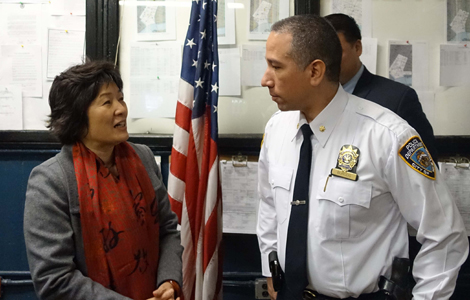
 Across America Over the Week (Jan 16 - Jan 22)
Across America Over the Week (Jan 16 - Jan 22)
 Spend Chinese New Year in style
Spend Chinese New Year in style
 Ili river valley becomes a popular destination for swans
Ili river valley becomes a popular destination for swans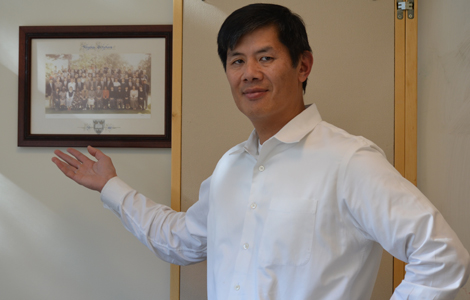
 Philip Ma: from scientist to businessman
Philip Ma: from scientist to businessman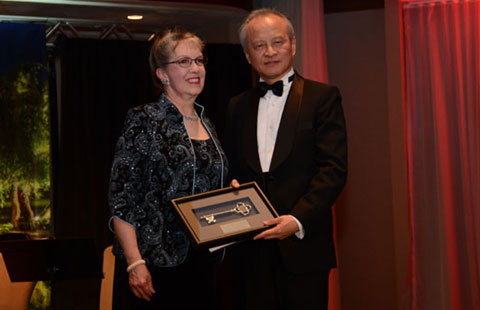
 Birmingham's Spotlight on China dinner
Birmingham's Spotlight on China dinner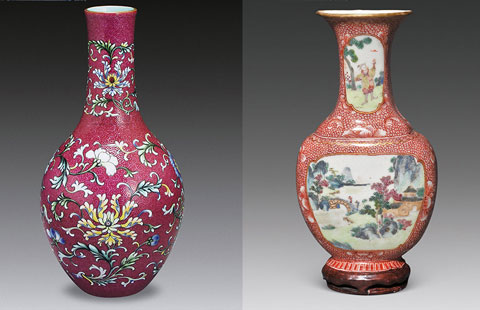
 How to distinguish doucai, wucai, Famille-rose and enamel porcelain
How to distinguish doucai, wucai, Famille-rose and enamel porcelain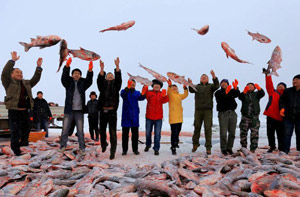
 Xinjiang lake in bumper fishing season
Xinjiang lake in bumper fishing season
 Senior maternity matron a high-income job
Senior maternity matron a high-income job
Most Viewed
Editor's Picks

|

|

|

|

|
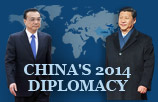
|
Today's Top News
Houston's SW Chinatown
China to focus on reforms, opening of capital market
Slowdown brings new risks to banks
Trade group calls for BIT
Market status for China is 'political' issue
Birmingham's Spotlight on China dinner
Bank takes renminbi-clearing seriously
Traditional Garb
US Weekly

|

|







